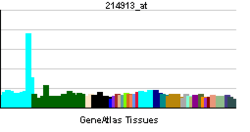ADAMTS3
A disintegrin and metalloproteinase with thrombospondin motifs 3 is an enzyme that in humans is encoded by the ADAMTS3 gene.[1][2]
This gene encodes a member of the ADAMTS (a disintegrin and metalloproteinase with thrombospondin motifs) protein family. Members of the family share several distinct protein modules, including a propeptide region, a metalloproteinase domain, a disintegrin-like domain, and a thrombospondin type 1 (TS) motif. Individual members of this family differ in the number of C-terminal TS motifs, and some have unique C-terminal domains. The protein encoded by this gene is the major procollagen II N-propeptidase. A deficiency of this protein may be responsible for dermatosparaxis, a genetic defect of connective tissues.[2]
References
- ↑ Tang BL, Hong W (Apr 1999). "ADAMTS: a novel family of proteases with an ADAM protease domain and thrombospondin 1 repeats". FEBS Lett 445 (2–3): 223–5. doi:10.1016/S0014-5793(99)00119-2. PMID 10094461.
- ↑ 2.0 2.1 "Entrez Gene: ADAMTS3 ADAM metallopeptidase with thrombospondin type 1 motif, 3".
Further reading
- Tang BL (2001). "ADAMTS: a novel family of extracellular matrix proteases". Int. J. Biochem. Cell Biol. 33 (1): 33–44. doi:10.1016/S1357-2725(00)00061-3. PMID 11167130.
- Martel-Pelletier J, Welsch DJ, Pelletier JP (2002). "Metalloproteases and inhibitors in arthritic diseases". Best practice & research. Clinical rheumatology 15 (5): 805–29. doi:10.1053/berh.2001.0195. PMID 11812023.
- Hirohata S (2002). "[ADAMTS family--new extracellular matrix degrading enzyme]". Seikagaku 73 (11): 1333–7. PMID 11831030.
- Nagase T, Ishikawa K, Nakajima D et al. (1997). "Prediction of the coding sequences of unidentified human genes. VII. The complete sequences of 100 new cDNA clones from brain which can code for large proteins in vitro". DNA Res. 4 (2): 141–50. doi:10.1093/dnares/4.2.141. PMID 9205841.
- Hurskainen TL, Hirohata S, Seldin MF, Apte SS (1999). "ADAM-TS5, ADAM-TS6, and ADAM-TS7, novel members of a new family of zinc metalloproteases. General features and genomic distribution of the ADAM-TS family". J. Biol. Chem. 274 (36): 25555–63. doi:10.1074/jbc.274.36.25555. PMID 10464288.
- Fernandes RJ, Hirohata S, Engle JM et al. (2001). "Procollagen II amino propeptide processing by ADAMTS-3. Insights on dermatosparaxis". J. Biol. Chem. 276 (34): 31502–9. doi:10.1074/jbc.M103466200. PMID 11408482.
- Colige A, Vandenberghe I, Thiry M et al. (2002). "Cloning and characterization of ADAMTS-14, a novel ADAMTS displaying high homology with ADAMTS-2 and ADAMTS-3". J. Biol. Chem. 277 (8): 5756–66. doi:10.1074/jbc.M105601200. PMID 11741898.
- Strausberg RL, Feingold EA, Grouse LH et al. (2003). "Generation and initial analysis of more than 15,000 full-length human and mouse cDNA sequences". Proc. Natl. Acad. Sci. U.S.A. 99 (26): 16899–903. doi:10.1073/pnas.242603899. PMC 139241. PMID 12477932.
External links
| |||||||||||||||||||||
